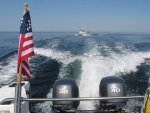Martin,
I have twin 40 Yamis, (like yours maybe) mine are carbed. I bought my boat used (very lightly -- 80 hours) and it was set up to go to Alaska by Jim, who had owned 33 previous boats. Jim's Dorie was to be his retirement boat. His plans didn't work out for him, but sure did for me. Anyway, Knowing now what I do,
IF I were buying new, I would opt for twin 50's, the EFI version. Barry already cited
the main reason, the engines would work less hard at cruising speeds. Maybe only 10%, but then that would just be that extra comfort cushion I like.
The second reason, the
50 EFI has the electronic output to feed engine data
to my RayMarine
MFD (multifunction display). That would give me fuel flow, and that would be a plus, because, as ypou may know, the FlowScan does not work reliably with the smaller flows that we have in our little engines

The
third reason is that I believe
a single 50 could get a 22 up on plane, if loaded and trimmed right. Not that I would want that as a usual practice, but if in an emergency....... Late last season I repropped, and I will try it again with my 40's but with 2 onboard and the old props (ProPulse "plastic") it was not possible to get up on step.
I believe the 40 and 50's are pretty close in size weight, and fuel burn so the main difference is the initial $$$ out. I have used them with a single up, and at slow cruise, the 40s do fine, (Jim knew what he was doing) so for me it is just the extra cushion that is the main difference. If I ever were to repower, it would be to 50's I think. It would definitely be to twins :thup :thup and it would (at least currently) be to Yamaha :thup :thup
Harvey
SleepyC :moon


